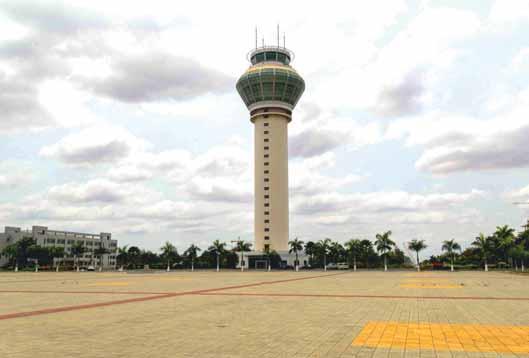
13 minute read
Novo Aeroporto de Luanda já “dinamiza” Bom Jesus
NEW LUANDA AIRPORT ALREADY “BOOSTS” BOM JESUS
O Novo Aeroporto Internacional de Luanda (NAIL), inicialmente nas mãos do China International Fund (CIF), ganhou novo impulso: realizou voo teste, deve começar apenas com operações de carga e já provoca transformações nas zonas circundantes. The New International Airport of Luanda (NAIL), initially in the hands of China International Fund (CIF), gained new impetus: it conducted a test flight, should begin only with cargo operations and is already causing transformations in the surrounding areas.
Advertisement
TEXTO TEXT LADISLAU FRANCISCO FOTOGRAFIA PHOTO ISIDORO SUKA
o surgimento do novo aeroporto internacional levou ao realojamento das populações do bairro 35 para uma zona próxima de Catete e a um aumento na procura de terrenos no bairro 44. Domingos José, jovem residente daquela zona, disse à Economia & Mercado que a zona está mais valorizada, mais movimentada, mas lamenta o facto de que, desde que o NAIL recebeu o voo experimental, os preços dos produtos e serviços tenham subido muito. “Só espero que não venha apenas para provocar aumento dos preços dos produtos, mas que também nos traga empregos e outras oportunidades”, rematou. Por sua vez, Madalena Manuel que reside na zona desde 2012, não se lembra de ver a mesma tão movimentada como agora e espera que o novo aeroporto traga mais empresas para a zona e, consequentemente, mais oportunidades de empregos para os jovens que ali residem. Descrito como um dos maiores aeroportos de África, pela Nor e gestão da obra), o NAIL vai ter capacidade para um volume de mercadorias de 50 mil toneladas/ ano, e vai ocupar uma área de the appearance of the new international airport led to the relocation of the residents of neighborhood 35 to an area near Catete and to an increase in the demand for land in neighborhood 44. Domingos José, a young resident of that area, told Economia & Mercado that the area is more valued, busier, but regrets the fact that since NAIL received prices of products and services have risen a lot. “I just hope that it doesn’t come only to raise the prices of products, but also to bring us jobs and other opportunities”, he remarked. For her part, Madalena Manuel, who has lived in the area since 2012, does not remember seeing it as busy as it is now and hopes that the new airport will bring more companies to the area and, consequently, more job opportunities for the young people who live there. Described as one of the largest airports in Africa by Norvia (the company supervising and managing the project), NAIL will have a cargo capacity of 50 thousand tons/year, and will occupy an area of 1,324 hectares, with two double runways, both with capacity to receive B747 and A380 type aircraft (currently the largest commercial aircraft), and six adjacent buildings, three of which have already been built, as well as an airport city that will cover a construction area of 75 square kilometers. If it comes to be as planned, the Dr. António Agostinho Neto airport, as the New International Airport of Luanda (NAIL) has been called, will be the largest airport in Africa, since it will have the capacity to receive 15 million passengers per year. To get an idea of the size of this airport that is “being born” in the district of Bom Jesus, Icolo e Bengo municipality, Luanda, just imagine that the NAIL will have almost double the capacity of the largest airport on the continent, the OR Tambo Inter-
1.324 hectares, com duas pistas duplas, ambas com capacidade para receber aeronaves do tipo B747 e A380 (actualmente o maior avião comercial), e seis edifícios adjacentes, três dos quais já construídos, bem como uma cidade aeroportuária que cobrirá uma área de construção de 75km quadrados. Caso venha a ser como o planeado, o aeroporto Dr. António Agostinho Neto, como se denominou o Novo Aeroporto Internacional de Luanda (NAIL) será o maior aeroporto de África, já que terá capacidade para receber 15 milhões de passageiros por ano. Para se ter ideia da dimensão deste aeroporto que está a “nascer” na zona do Bom Jesus, município de Icolo e Bengo, em Luanda, basta perceber que o NAIL terá quase o dobro da capacidade do maior aeroporto do continente, o aeroporto de Joanesburgo, na África do Sul, que tem capacidade para 8,2 milhões de passageiros por ano. longe dos números dos maiores aeroportos do mundo, nomeada Jackson, localizado em Atlanta, nos Estados Unidos, que recebe nada menos que 100 milhões de passageiros todos os anos, com uma média de 2.500 voos a cada intervalo de 24 horas, ou do Aeroporto Internacional de Pequim, na China, que recebe mais de 95 milhões de pessoas todos os anos.
Mais um “elefante branco”?
Apelidado de maior “elefante branco” de África pelo jornalista e activista Rafael Marques, o novo aeroporto de Luanda deve custar 3,8 mil milhões de dólares, como se pode ver no site da construtora norvia, responsável obra foi inicialmente orçada em 300 milhões de dólares, e chegou mesmo a ser orçada em 9 mil milhões de dólares. A empreitada que começou no reinado de José Eduardo dos Santos foi, inicialmente, entregue à China International Fund (CIF). çou, até vir a ser afastada “por inconformidades e incapacidade declarada”, já depois da chegada de João Lourenço à Cidade Alta. É assim que em Maio de 2020 foi assinada uma adenda ao contrato de empreitada do projecto de construção do Novo Aeroporto Internacional de Luanda (NAIL), dando a obra à China National Aero-Technology Internacional Engineering (AVIC). O Executivo angolano garantiu, naltura, que a adenda permitia a obtenção minação de quaisquer encargos adicionais para o Estado. Na mesma altura, o Mistério dos Transportes foi orientado a pro ceira do projecto do NAIL, com vista a sua conclusão, assegurando assim um melhor alinhamento com os vários departamentos o conjunto de acções tendentes à cimento de um novo cronograma de acções. Dalí para a frente foi sempre a acelerar, até a realiist and activist Rafael Marques, Luanda’s new airport should cost USD 3.8 billion, as can be seen on the website of the construction company Norvia. However, the work was initially budgeted at USD 300 million, and was even, at some point, budgeted at USD 9 billion. The contract that began during the reign of José Eduardo dos Santos was initially given to China International Fund (CIF). After 15 years, little progress was made, until it was removed “due to non-conformities and declared incapacity” after João Lourenço’s arrival Uptown. In May 2020, an addendum to the contract for the construction of the New Luanda International Airport (NAIL) was signed, giving the work to China National AeroTechnology International Engineering Company (AVIC). The Angolan Government assured, at the time, that the addendum and the elimination of any additional costs for the State. At the same time, Ministry of Transport was instructed to proceed with the technical and project, with a view to its conclusion, thus ensuring better alignment with the various related ministerial departments, as well as with the set of ac of NAIL and the establishment of a new schedule of actions. From that point onwards, the pace was always accelerated,
APELIDADO DE MAIOR “ELEFANTE BRANCO” DE ÁFRICA PELO JORNALISTA E ACTIVISTA RAFAEL MARQUES, O NOVO AEROPORTO DE LUANDA DEVE CUSTAR 3,8 MIL MILHÕES DE DÓLARES. Nicknamed the biggest “white elephant” in Africa by journalist and activist Rafael Marques, the new Luanda airport is expected to cost USD 3.8 billion.
national Airport in Johannesburg, South Africa, which can handle up to 8.2 million passengers per year. However, NAIL is expected to fall short of the numbers of the largest airports in the world, son airport, located in Atlanta, in the United States, which receives no less than 100 million passengers every year, every 24 hours, or the Beijing International Airport, in China, which receives more than 95 million people every year.
Another “white elephant”?
Nicknamed the biggest “white elephant” in Africa by journal-
4 DE FEVEREIRO PARA AVIAÇÃO EXECUTIVA February 4 for executive aviation
Relativamente ao actual aeroporto internacional de Luanda, o 4 de Fevereiro, o ministro dos transportes Ricardo de Abreu disse em entrevista a comunicação social que não há perspetivas de o encerrar e deverá continuar com a operação, mesmo depois da entrada em operação do novo aeroporto. "Consideramos que todo o trabalho que fizemos de reformas estruturais a nível do sector e aquilo que pode ser o potencial de crescimento do sector da aviação civil em Angola, permitenos pensar termos dois aeroportos", realçou o responsável que disse ainda que o actual 4 de Fevereiro deverá servir para aviação executiva, enquanto que no futuro aeroporto internacional de Luanda vai servir aos voos internacionais e voos domésticos. Regarding Luanda's current international airport, the 4 de Fevereiro, Transport Minister Ricardo de Abreu said in an interview with the media that there are no prospects of closing it and it should continue with operations, even after the new airport comes into operation. "We consider that all the work we have done of structural reforms at the level of the sector and what may be the growth potential of the civil aviation sector in Angola, allows us to think of having two airports”, stressed the official who also said that the current 4 de Fevereiro should serve for executive aviation, while the future Luanda international airport will serve international and domestic flights.
zação do voo teste, no caso um Boeing 777-300 da TAAG no dia 17 de Junho de 2022, que represen ção internacional do aeroporto.
Aeroporto começa com operação de carga
Com entrega da obra prevista para Junho de 2023, levanta-se a questão de vir a acontecer an estar concluído, e assim abre-se a porta para a possibilidade de o Novo Aeroporto Internacional de Luanda (NAIL), Dr. Agostinho Neto, arrancar exclusivamente com a operação de carga. Um período que servirá também de teste às infra-estruturas e que deve permitir preparar a operação com passageiros de forma mais estruturada. Com esta solução, o Executivo “mata dois coelhos com um tiro”, já que dá utilidade ao NAIL en tempo dá vazão ao acordo de transporte de carga que pretende transformar Angola num hub em África. O Executivo, por meio da TAAG, assinou acordo com um grande operador chinês, nomeadamente China Lucky Aviation, para que a TAAG disponibilize, duas vezes por semana, um dos seus aviões do modelo Boeing 777-300 ER com capacidade de 76 toneladas de carga para o transporte de mercadorias, gerando uma renda de 200 milhões dólares por ano. Questionado sobre essa solução, o economista António Cangavo disse que a operação de carga pode incentivar o desenvolvimento das estruturas de apoio à volta do aeroporto, as empresas nessa zona, dando assim início ao que se espera que venha a ser uma nova cidade aeroportuária. Esta solução também dá tempo para organizar o tráfego de passageiros, que se apresenta mais complexo e com maior necessidade de pessoas e de equipamentos. Por sua vez, o especialista em urbanismo, Clemente Evangelista, referiu que o surgimento da infra-estrutura poderá ter efei que dependam do envio e recepção de pequenas bagagens que venham de avião, mas “são certamente poucas, já que a maior parte depende mais dos Portos”.
CORRIGIR ERROS DO PASSADO Correcting past mistakes
A fim de evitar o problema de ter um aeroporto instalado em plena zona habitacional, o Executivo já afastou os bairros adjacentes ao aeroporto, sendo que o mais próximo é o bairro denominado 44, que dista a cerca de 4km do NAIL. Lá, já se sentem os efeitos do surgimento desta nova infra-estrutura. Os anteriores residentes do bairro 35 foram realojados num bairro denominado Ngombe, situado junto ao desvio de Catete. Por outro lado, há a questão dos acessos ao NAIL que certamente serão motivos de uma nova avaliação, já que, apesar de ter a ligação via estrada, há a necessidade de se pensar numa segunda ligação por estrada e mesmo por metro ou comboio. To avoid the problem of having an airport installed in the middle of a residential area, the Executive has already removed the neighborhoods adjacent to the airport, the closest one being the neighborhood called 44, which is about 4km from NAIL. There, the effects of the emergence of this new infrastructure are already being felt. The former residents of neighborhood 35 were relocated to a neighborhood called Ngombe, located near the Catete bypass. On the other hand, there is the issue of access to NAIL that will certainly be the reason for a new evaluation, since, despite having the connection via road, there is the need to think about a second connection by road and even by subway or train.
Infra-estruturas de transporte
O novo aeroporto está a ser construído na zona do Bom Jesus, município de Icolo e Bengo, em Luanda, e só por isso já tem tudo “contra si”, refere o professor de urbanismo e ambiente, Clemente Evangelista, que apontou a a fraca oferta de transportes públicos na zona, apesar do esforço feito pelo Executivo, na construção da linha de comboio, nomeadamente a linha do Bungo e a estrada que permite que se saia do centro e arredores da cidade e se chegue ao aeroporto em 15 ou 20 minutos no máximo. Mas ao mesmo tempo, defende o especialista, o Estado abre a oportunidade para que a referida zona tenha um aumento da actividade económica, já que o aeroporto é dos maiores factores de desenvolvimento que se pode colocar numa região. a Boeing 777-300 from TAAG on June 17, 2022, which represented a clear sign of the in airport.
Airport begins with cargo operation
With project completion planned for June 2023, the question arises whether it will process is completed, and thus opens the door for the possibility of the New International Airport of Luanda (NAIL), Dr. António Agostinho Neto, to start exclusively with the operation of cargo. A period that will also serve to test the infrastructure and should allow for the preparation of passenger operations in a more structured way. With this solution, the Government “kills two birds with one stone”, since it makes NAIL useful while it waits for the end of to the cargo transport agreement that intends to transform Angola into a hub in Africa. The Executive, through TAAG, signed an agreement with a large Chinese operator, namely China Lucky Aviation, so that TAAG will make available, twice a week, one of its Boeing 777-300 ER model airplanes with a cargo capacity of 76 tons for the transportation of goods, generating an income of USD 200 million per year. Asked about this solution, economist António Cangavo said that the cargo operation can encourage the development of support structures around the airport, logistics companies will tend to settle in that area, thus starting what is expected to be a new airport city. This solution also gives time to organ more complex and requires more people and equipment. In his turn, urbanist Clemente Evangelista, referred that the appearance of the infrastruc fect for the entities that depend on the sending and receiving small luggage that comes by plane, but “they are certainly few, since most of them depend more on the Ports”.
Transportation infrastructure
The new airport is being built in the district of Bom Jesus, Icolo e Bengo municipality, Luanda, and this alone has everything “against it,” according to the professor of urbanism and environment, Clemente Evangelista, who pointed out the poor supply of public transport in made by the Executive, in the construction of the train line, namely the Bungo line and the road that allows one to leave the center and outskirts of the city and reach the airport in 15 or 20 minutes at the most. But at the same time, defends the specialist, the State opens the opportunity for the referred area to have an increase in the economic activity, since the airport is one of the greatest factors of development that can be placed in a region.










